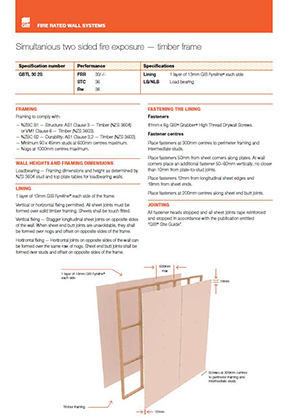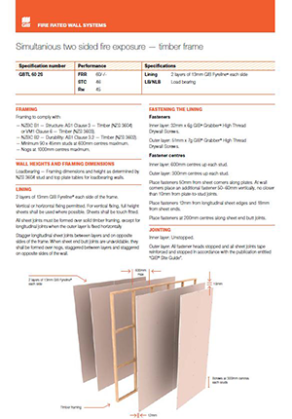Articles | Technical
Innovation Review: GIB® Fire Rated Wall Systems Subjected to Simultaneous Two-sided Fire Exposure
Thursday, 22 September 2022
By Frank Kang
The standard furnace test for fire-resistance represents the scenario where a fire-rated wall, acting as a separating element, is exposed to fire from one side. However, like a column or beam located within a fire compartment, walls required to perform a structural function are not always fire separations and can be exposed to fire on both sides simultaneously.
A conventional fire resistance rating (FRR) for a wall system applies from either direction and is expressed in minutes, representing structural adequacy/integrity/insulation where the exposed and unexposed linings contribute, particularly as it relates to the unexposed face temperature rise (the insulation criterion). Structural adequacy represents the ability of a wall to resist applied gravity loads under standard fire exposure conditions. Due to increased stud char, the structural adequacy of a timber-framed wall, tested from one side, cannot be applied when exposure is from both sides simultaneously.
Research at the University of Canterbury (Kang, 2021), which I completed as part of my Master of Engineering in Fire Engineering degree, has developed a predictive method to assess the structural adequacy of timber-framed load-bearing plasterboard lined walls, subjected to simultaneous two-sided fire exposure. Abaqus/CAE finite element modelling was developed and validated by comparing predictions with experimental results. Three full-scale fire resistance tests, designed to expose the specimen on both sides simultaneously, were conducted at BRANZ as part of the research.
Extended furnace beyond the specimen.
Shortened load-bearing specimen with wall openings at each end.
This research was presented at the Asia-Oceania Symposium on Fire Science and Technology Conference in 2021 and the Fire NZ Conference in 2022, and received positive responses from attendees. Polytechnic Institute of Bragança also expressed interest in utilizing the experimental results to validate their finite element models, and a journal article with lecturers at University of Canterbury on the experiment, will get underway soon.
Combining the approaches in ‘GIB® Fire Rated Systems, 2018’ and the simplified method from the research shows that structural adequacy under simultaneous two-sided exposure is achieved with GBTL 60 for 30 minutes, and GBUW 60 each side for 60 minutes. On this basis, two specifications called GBTL 30 2S and GBTL 60 2S have been developed to make it easy to specify and install. Refer to ‘GIB® Fire Rated Systems Supplement’ document for complete details.
The full thesis is accessible online from the University of Canterbury Research Repository.
Reference: Kang, H. (2021). The Performance of Timber-framed Load-bearing Gypsum Plasterboard Walls Subjected to Two-sided Fire Exposure. University of Canterbury, Christchurch, New Zealand.
Read next
Articles | Events
Master Builders Association Commercial Project Awards
Wednesday, 17 August 2022 By Clara Sumner

